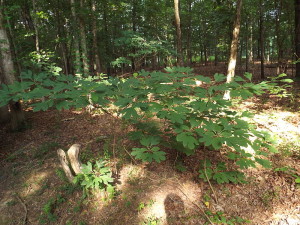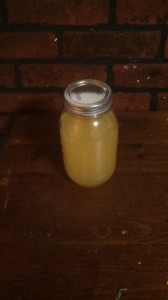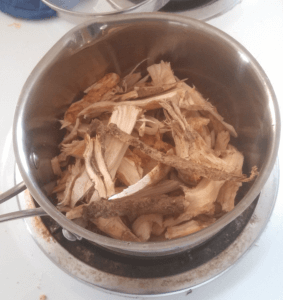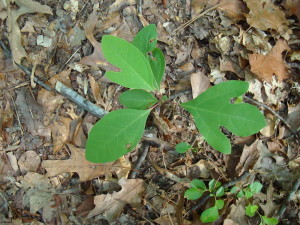Sassafras Tree
Sassafras is the primary ingredient in traditional root beer as well as being used in the production of MDMA(ecstasy) and MDA. Sassafras tree (Sassafras albidum) is a very common native plant in the Eastern United States. It is often seen in clumps of weedy saplings, but as sassafrases mature they can grow to be large trees. There are lots of controversies and conspiracy theories relating to Sassafras and its active compound safrole. Sassafras is an ancient healing plant for eastern native american tribes. It is also the characteristic flavoring of traditional root beer. So why has our government made it illegal to sell safrole? Click hear to learn about the History and controversy around Sassafras.

Sassafras Uses – Edibility and Culinary

Sassafras Root
Sassafrases are known for their fragrance and flavor. The root and stems have uniquely different fragrances and flavors. The roots have the smell of root beer since they were one of the primary plants used in making traditional root beer. The stems have a slightly more citric smell. Safrole is the component in the plant that gives it it’s unique fragrance and flavor. The roots or stems are boiled to extract the safrole into the liquid, this liquid is then used in small amounts to add flavor to drinks such as tea and root beer. Safrole by itself is very bitter so sweeteners are often used to balance the flavor.
Sassafras Fruit
The Sassafras plant does produce small black sassafras fruit that also may be used as a flavoring but are very bitter and astringent if eaten without diluting them.
Sassafras Leaves
The plant’s leaves have a mucilaginous texture and can be used raw or cooked in salads or eaten right off the plant, unlike the berries, the leaves have a mild pleasant taste.
Sassafras Bark
The bark is different on the trunk vs on the root. Trunk bark has a different flavor then root bark and is used less often. To test this yourself you can scratch and sniff the trunk vs the root bark and you will notice a different fragrance.
Sassafras Drug
The safrole in sassafras can be used to make sassafras drugs such as MDMA(ecstasy) and MDA. These drugs have a long history of use as psychoactive drugs. The term sassafras drug is correctly applied to either of these drugs, more commonly MDA but it is also often incorrectly used to describe any number of drugs particularly including mixures with MDMA and/or MDA. The effects of these drugs vary but generally include mental and emotional stimulation such as increased empathy towards others, also one of the most profound effects is sensory stimulation. Sassafras drugs have also been used to help in cases of anxiety and PTSD. Sassafras drug has a long list of negative and potentially very dangerous side effects as well. The negative side effects have lead to both MDMA and MDA being classified as illegal class A substances in the U.S.
Sassafras Uses – Health Benefits
Sassafras Tea Benefits
Sassafras has a history of being a medicine with many uses. Primarily it is been used as a tonic and blood purifier. A tonic is a mild stimulant know to improve general health and mood over time. As a blood purifier Sassafras may help the body to speed up its rate of blood detoxification. Contrary to The tests done in the 1950s there is some evidence that Safrole may actually help to protect against cancer in humans since closely related compounds are known to do so.
Sassafras Root Beer

Sassafras is the primary flavor of traditional root beer. The other components vary, but generally include sugar and molasses, plus cloves, cinnamon and allspice. Allspice can be replaced by spicebush berries if your looking for more forageable ingredients. The first step to making sassafras root beer is to choose the right size sapplings. First and most importantly learn to identify sassafras correctly by smell and leaf shape. Sassafras root itself has a unique smell which is different from other parts of the plant. Choose saplings with 1/2″ – 1″ diameter sassafras roots, this size is good because it can be harvested relatively easily and contains a slightly denser concentration of safrole. Uproot the entire plant then wash and cut up the sassafras roots into 1/2″ – 1″ chunks(try to break up the chunks a little to allow access to the interior parts). Boil these pieces in water for about 15 minutes at which point you will notice a change in water color. Now you have the concentrated sassafras root tea you can dilute it with water and add it to the other ingredients in a pitcher or keep the components separate and make a different mixture per glass. Try out different proportions until you find the best recipe for your tastes. To make it a fizzy sassafras root soda make sure you add the sugar and some bakers yeast and let it ferment for a day or 2 in a closed container such as a 2 liter soda bottle with the cap on. Sassafras tea is included in our forageable tea index. Here is an easy recipe for Bubbly Sassafras Root Beer using seltzer water.
Sassafras Cautions
Besides for the dangerous side effects of Sassafras drugs a government study showed that safrole may be carcinogenic. Although this is doubtful to be true when consuming reasonable amounts of the plant, if the plant is consumed in extremely large quantity for long periods of time it could be carcinogenic. If large amounts of the concentrated oil from the plant is consumed it could lead to acute poisoning which may seriously damage the kidney and liver. You can learn more about the symptoms of kidney and liver damage at CPOE.org.
Key ID Features – Look for the distinguished sassafras leaf
Sassafras is a deciduous tree that is often seen in groups of saplings but single trees can get to be up to 85’ tall. This plant has a couple very good identification features: the first one is that a sassafras leaf can have 1,2, or 3 lobes all on the same plant. Younger plants often have more 2-3 lobed leaves than older plants. On mature trees it may be hard to spot 2-3 lobed leaves. The second great identification feature is the smell. Scratch and sniff the roots and branches, you will notice similar but distinct fragrances. Both fragrances are strong, the roots smell somewhat like root beer and the stems are slightly more citric smelling. This makes Winter identification possible. You can purchase a live sassafras sapling HERE for planting, this will ensure correct identification.

Conclusion
Sassafras is a very unique plant, not many plants have such a strong, useful fragrance and ability to add such a great flavor. It is abundant and can be identified in the winter. It has an ancient history of health benefits and a controversial modern history making this plant even more attractive to learn about and appreciate. If you live in the Eastern United States, find a Sassafras tree and experience a flavorful medicinal plant that our culture has been lacking for the last 50 years.
Read our Article on: Safe Foraging
Many of our readers find that subscribing to Eat The Planet is the best way to make sure they don't miss any of our valuable information about wild edibles.
See our privacy policy for more information about ads on this site







42 Responses
I had been eating and drinking Sassafras all my life as a Child. Walking threw the woods I would grab a a young tree pull up the root knock off the dirt rub the rest off and start chewing it the root itself….. I would pull up the trees collect them in brown paper bags take the roots home too boil as a Tea. Very Good Very tasty. I had a Friend how was diagnosed with Cancer and she Could not hold anything down I went to the woods gotten her a Bunch of Sassafras root had her chew the root and it eased her stupid pains told to continue to chew when she had pain she did and the pains would go away she is now in remission. …..
sad part is I now live on the Gulf Coast and can not find it Very Saddening for Me…..
I had been eating and drinking Sassafras all my life as a Child. Walking threw the woods I would grab a a young tree pull up the root knock off the dirt rub the rest off and start chewing it the root itself….. I would pull up the trees collect them in brown paper bags take the roots home too boil as a Tea. Very Good Very tasty. I had a Friend how was diagnosed with Cancer and she Could not hold anything down I went to the woods gotten her a Bunch of Sassafras root had her chew the root and it eased her pains told to continue to chew when she had pain she did and the pains would go away she is now in remission. …..
sad part is I now live on the Gulf Coast and can not find it Very Saddening for Me…..
Thats very interesting about the friend with cancer. I really like hearing people’s personal experiences with wild edibles.
My father grew up in Renovo, Pa. As a child he would harvest Sassyfras. That is what he called it.During the great depression food in coal regions of Pa , food was scarce. Sassyfras helped to stave off hunger.
Is there no way to obtain sassafras root? My mom use to always fix sassafras tea for me when I would have one of my coughing spells. My uncle would always bring some up from the southern part of the state but he has passed.
You can buy it on Etsy.
I live on the gulf coast and my yard is surrounded by sassafras…..i think most places in city limits have eradicated it,my house was built in the 1930’s and i am the third occupant,so i have a lot of old trees and shrubs,sassafras grows like a weed by the way,,,,fast and regular
Hi Wayne, Is there any way I could buy some of this from you? I have a friend with some strange auto-immune disease as well as PTSD from spousal abuse, and I’m trying to find ways to help her.
Please reply when you have a moment. Thank You
what we have been taught as weeds is wrong. almost every weed is beneficial
Including MaryJane. Just a hollow stem weed. Our government outlawed it to. I’m sure it’s all just a big coincidence. Surely not to profit pharma
Grows wild in the woods behind the house my sister rents and in front of the apartment across the street from my apartment. People across the street from me keep cutting it down and it keeps coming back. From what I was told it is against federal law to harvest it. Is this true?
Yes, the FDA listed it as a class A drug. Not only was it used for pain and PTST. They found the hallucination and euphoria were included in the effects. They also said it damages the liver, causes high Blood Pressure and Cancer, vomiting…. just Google Medical Effects of Sassafras and you can read the “Medical” interpretation and how big companies like Stewert Root Beer, used it boiled to add the root beer flavor to their famous soda. They probably still do. I drank it all my life and never had any of the side effects, however the Government compared the Euphoric affect the same as Ecstasy.
Just buy an indoor plant
I heard that sassafras was illegal from a friend but didn’t really understand. So I googled for “what is sassafras” and found your blog. It’s so interesting that it has so many uses from using the sassafras root to make sassafras root beer, and sassafras’s role as a blood purifier. Really interesting article!
My understanding is that it is not illegal. Government tried but because it was a wild plant, Delaney amendment did not apply. Was largely withdrawn by marketers for fear of law suits not for fear of prosecution. Again, this is only my understanding and I am not taking time to confirm.
I have this shrub everywhere on my property and was curious what it was, Now I know!! Thank you so much for your article and helpful information about this very intriging and unique shrub.
It is not a shrub. It is a tree that can grow very large, up to 100+ feet. It usually grows in small clusters.
It was and sometimes still is used to make furniture.
Grows as a shrub if you keep it trimmed back. Only old ones reach tree height. The ones around here rarely reach more than 40 feet tall and average around 6-10 feet.
I find it interesting that you make no mention that dry sassafras leaves are used to make file powder. File powder is a seasoning commonly used in Cajun and Creole style recipes such as Gumbos.
True I make gumbo quite often and I use the file’ powder to thicken and flavor my gumbo..
My little dog has been eating these weeds for a few years now. He loves them and hunts especially for them. I have not been able to identify them until now when I have discovered they are a form of Sassafras. I am very happy to find out it isn’t something that will harm him. I think I will try making some tea out of some of the leaves.
The leaves are edible when they’re very young and still light green. Dried and ground into a powder called filé, you add them to soups after the soup is done, to make gumbo. You can also purée the fresh leaves with soup stock in a blender, and add that to the finished soup for the same result.
The root cambium, the white layer between the bark and the hard, inner wood, is an incredible culinary seasoning, like a combination of cinnamon, anise, and root beer.
I wondered as I read this if anybody still remembered Gumbo File! The stuff they sell in the stores now is mostly, if not all, thyme!
This is why Cajuns are such nice people lol; we eat sassafras in our gumbo all the time ?
I find the berries to be pleasant. Not astringent or bitter, but nicely aromatic. Maybe it’s the growing conditions of the trees, from which we eat. We are making our first sassafrass fruit extract this fall. Harvested them with my daughter last night. We are including the beautiful, swollen red predicles. Those parts intuitively seem like good balance to the midnight black fruit. Not sure whether to crush the seed and include them. Probably not, since the tree intends for them to be passed through the gi tract unharmed. Any tips on extraction process would be appreciated. I’m thinking a standard alcohol tincture with 50% grain alcohol. They are much more tender and yin than the tough root, which requires boiling. Perhaps even a cold water, sun drenched infusion?
The berries are edible and not poisonous?
Wow I’m amazed and grateful for all the comments this is amazing.
I haven’t gotten into alcohol extracts much. If anything I mostly do infusions. Let me know how it works out.
I have a whole fence a row of sassafras. I’m 5’10” and they’re alot taller than I am. Their leaves are the first to change a nice red color. Signals falls on the way !
Acorns provide food for various wildlife, or they would otherwise litter the forest floor and rot since they are too heavy to disperse via wind. … Only one type of tree produces an acorn, but …
Our abundant sassafras trees are all dying off. Invasive vine, mock bittersweet is strangling them and there seems to be some sort of (parasitic?) disease harming them. Yesterday we had to pull down one that was going to fall in the driveway. It had the first leaves/blossoms on the twig ends. It smelled so good that I ‘harvested’ all of those twigs and stuck them in a glass jar with water. Are those first spring green parts also edible?
I eat the green shoots and leaves with no noticeable negative side effects. Sometimes the flavor can be a bit too strong and bitter depending on what part you eat. I never have any trouble with the taste of the fresh leaves.
The pharmaceutical industry probably wants Sassafras gone. Heaven forbid people heal themselves without expensive pharmaceuticals.
Very informative, thank you.
Are you selling huckleberry and sassafras? If so I’d like to purchase.
Thanks
Mrs J.
Hi there, I was drugged as a teen and was wondering if anyone has used sassafrass substance to help release any buried memories? I have a suspicion the guy who did this used this “natural” stimulant. If someone has had too much, could it possibly cause someone to be ill to their stomach and throw up? Thanks in advance..
In the FDA study showing dangers from taking sassafrass, they used astronomical amounts of sassafrass. Many many many many many times more than you would ever get making root beer. This was done so they could ban it to help protect big pharma. The health benefits of sasssafrass are not patentable and root beer is a lot cheaper than the drugs.
There is absolutely no danger in using sassafrass root.
True and what’s more, there are substances that are very similar to safrole (generally called phenylpropanoids) found in substantial amounts in basil, anise, parsley, allspice, dill…. I’m pretty sure that if you eat astronomical amounts of these that they would cause liver damage as well.
I had no idea sassafras was banned?! We have it everywhere on our property in central KY. My kids and I love the interesting and varied leaf shapes! I would love to try to make root beer. Do you need to harvest the root at a certain time of year? we are moving into late fall now. My kids apparently googled sassafras to learn the spelling and your site popped up!
As far as I know, sassafras is not illegal. Big Pharma would like to let everyone think it is, though.
The studies were flawed. as well, it appears.
All parts of the sassafras plant are legal, but I wouldn’t be surprised if you order say 25 kilograms of the rootbark that you’ll receive a visit by the authorities to check up on what you plan to do with it. Small amounts should be fine. Only the essential oil is restricted, and all sales above the amount of 10 ml must be reported to the DEA.
Back when the essential oil was still available to the public, it didn’t even come from the Sassafras tree, because of limited availability it would be expensive. It was sold as Sassafras oil, but in fact it yellow camphor oil, which was obtained from camphor trees, which grow like weeds all over the tropics.
Sassafras oil is an ingredient in award-winning Windsor soap that was popular during the 19th century. I guess you could just use a decoction of the bark as well when making this soap, as all sales of the oil to the public over the amounts of 10 ml must be reported. It sucks but it is what it is and we have to make do with what we have.